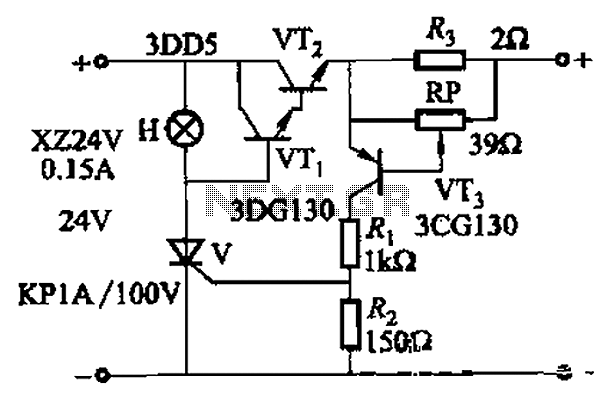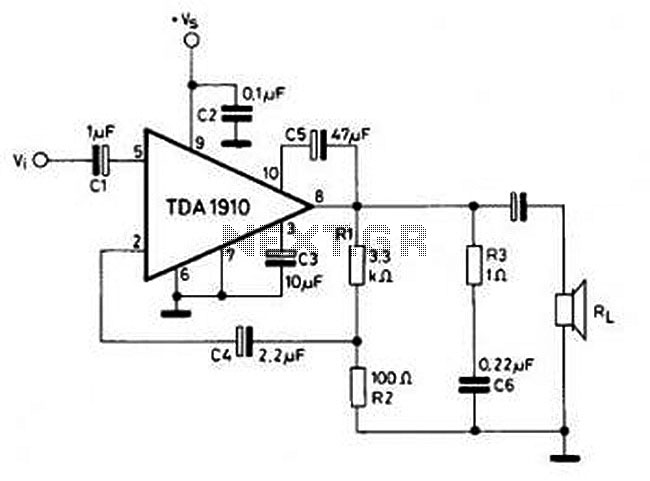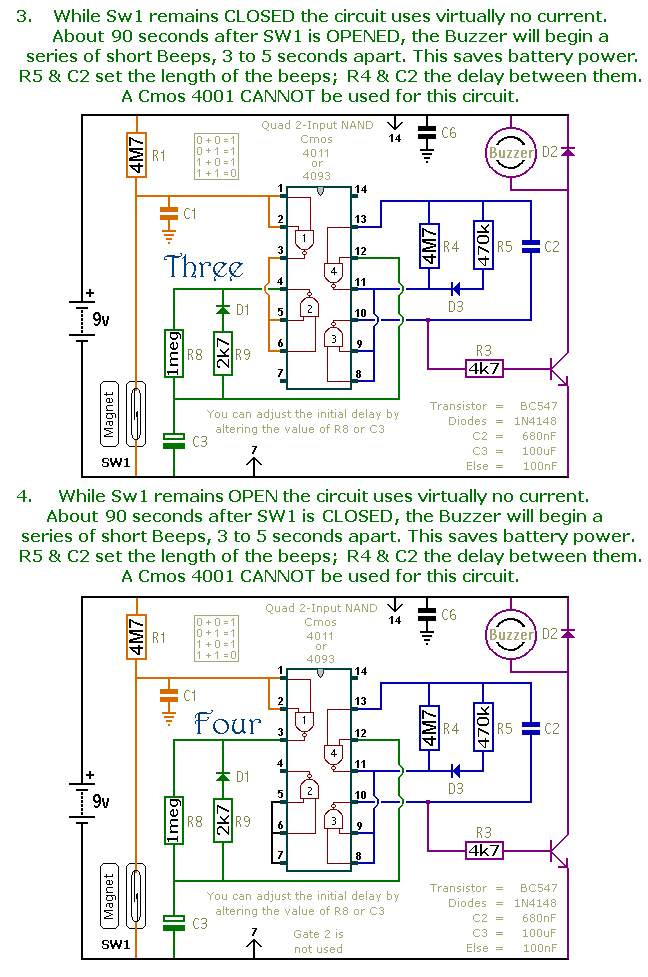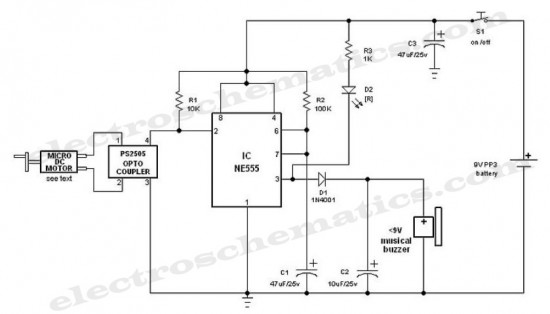
White LED Drive Circuit
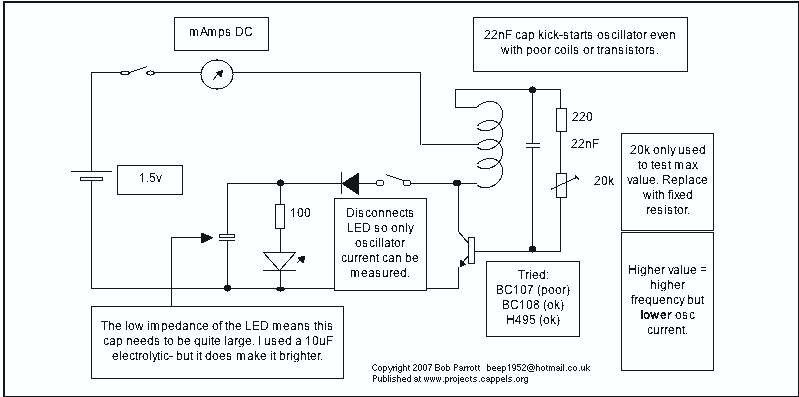
A minimum number of parts yields a compact switching converter that can provide sufficient voltage to drive white LEDs. The resulting lamp is much more efficient, in terms of lumen hours per pound of battery, than incandescent bulbs, and because the color of the light is determined by fluorescence of phosphors within the LED assembly, the color of the lamp does not change perceptibly as the battery runs down. As a result, very long battery life is achievable. This circuit is suitable for powering flashlights, emergency lighting, and other applications in which it is desirable to power white LEDs from one or two primary cell batteries using a low cost circuit. More: The circuit could not be simpler than this. The transistor, 1K resistor and the tapped inductor form a blocking oscillator. When the power button is pressed, the transistor is biased on through the 1 k resistor. Voltage that appears from the tap on the inductor...
The described circuit functions as a compact switching converter designed to efficiently drive white LEDs, utilizing a minimal number of components. The core of the circuit includes a transistor, a 1 kΩ resistor, and a tapped inductor, which collectively create a blocking oscillator configuration. This configuration is pivotal in converting the low voltage from one or two primary cell batteries into a higher voltage suitable for LED operation.
Upon activation of the power button, the 1 kΩ resistor provides the necessary bias current to turn on the transistor. This action initiates oscillation within the circuit, where the inductor's inductance plays a crucial role in energy storage and transfer. The voltage induced from the tap on the inductor generates a higher voltage output, which is essential for powering the white LEDs efficiently.
The efficiency of this circuit design is further enhanced by the characteristics of the white LEDs, which utilize phosphors to produce light. This method of light generation ensures that the color remains consistent even as the battery voltage declines, contributing to an extended operational life for the device. Such features make this circuit ideal for applications requiring reliable and long-lasting lighting solutions, such as in flashlights and emergency lighting systems.
Overall, this simple yet effective design illustrates how a minimalistic approach to circuit design can yield significant advantages in terms of efficiency, cost, and longevity, making it an excellent choice for portable lighting applications.A minimum number of parts yields a compact switching converter that can provide sufficient voltage to drive white LEDs. The resulting lamp is much more efficient, in terms of lumen hours per pound of battery, than incandescent bulbs, and because the color of the light is determined by fluorescence of phosphors within the LED assembly, the color of the lamp does not change perceptibly as the battery runs down.
As a result, very long battery life is achievable. This circuit is suitable for powering flashlights, emergency lighting, and other applications in which it is desirable to power white LEDs from one or two primary cell batteries using a low cost circuit. The circuit could not be simpler than this. The transistor, 1K resistor and the tapped inductor form a blocking oscillator. When the power button is pressed, the transistor is biased on through the 1 k resistor. Voltage that appears from the tap on the in 🔗 External reference
The described circuit functions as a compact switching converter designed to efficiently drive white LEDs, utilizing a minimal number of components. The core of the circuit includes a transistor, a 1 kΩ resistor, and a tapped inductor, which collectively create a blocking oscillator configuration. This configuration is pivotal in converting the low voltage from one or two primary cell batteries into a higher voltage suitable for LED operation.
Upon activation of the power button, the 1 kΩ resistor provides the necessary bias current to turn on the transistor. This action initiates oscillation within the circuit, where the inductor's inductance plays a crucial role in energy storage and transfer. The voltage induced from the tap on the inductor generates a higher voltage output, which is essential for powering the white LEDs efficiently.
The efficiency of this circuit design is further enhanced by the characteristics of the white LEDs, which utilize phosphors to produce light. This method of light generation ensures that the color remains consistent even as the battery voltage declines, contributing to an extended operational life for the device. Such features make this circuit ideal for applications requiring reliable and long-lasting lighting solutions, such as in flashlights and emergency lighting systems.
Overall, this simple yet effective design illustrates how a minimalistic approach to circuit design can yield significant advantages in terms of efficiency, cost, and longevity, making it an excellent choice for portable lighting applications.A minimum number of parts yields a compact switching converter that can provide sufficient voltage to drive white LEDs. The resulting lamp is much more efficient, in terms of lumen hours per pound of battery, than incandescent bulbs, and because the color of the light is determined by fluorescence of phosphors within the LED assembly, the color of the lamp does not change perceptibly as the battery runs down.
As a result, very long battery life is achievable. This circuit is suitable for powering flashlights, emergency lighting, and other applications in which it is desirable to power white LEDs from one or two primary cell batteries using a low cost circuit. The circuit could not be simpler than this. The transistor, 1K resistor and the tapped inductor form a blocking oscillator. When the power button is pressed, the transistor is biased on through the 1 k resistor. Voltage that appears from the tap on the in 🔗 External reference
